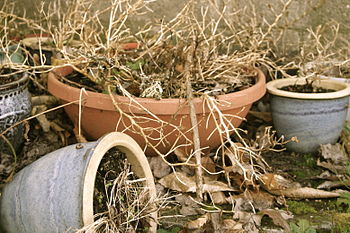 |
| Dead plant in pots (Photo credit: Wikipedia) |
1. LIGHT is the very first element to consider. In winter, when the light is not so strong, you can place your plants closer to the windows, and rotate them regularly so all the leaves receive enough light.
Choose the most appropriate location taking into account the following window orientations:
-North: it doesn't receive direct sunlight, but it is a good source of light for your plants. Most convenient in summer.
-South: it receives the most sunlight. Very convenient in winter.
-East: it allows early sunlight, which is very important for an excellent growing of your plants.
-West: it receives much sunlight, but its convenience depends on the amount of light the plant can receive.
2. TEMPERATURE is another key factor to consider because in winter we increase the temperature of the room via heaters, fireplaces and other heating devices. Plants suffer many times because of this, and we do not realize.
When the temperature of the room increases, the water of your plants evaporates quickly, and so it may be necessary to increase the amount of water they receive. As always, the exact amount of water will depend on the type of plant you have.
A solution to this is to place containers with water close to the plants. The leaves will absorb the water by transpiration, in a natural way.
And a quick reminder: although plants show beautifully when displayed on mantelpieces, remember to remove them before starting a fire, as the excess of heat could kill them.
3. WATERING your plants in winter is important for the reason told above. To water your plants properly, do so with abundant water fewer times, rather than with less water and very often.
The reason for this is because the water needs to reach all the roots of the plant, including the deepest ones. When you use abundant water, the plant does not need more water for a while, so you can space the watering.
If not watered properly, the plant may die, even though the surface of the soil may appear wet.
4. VENTILATION is a key factor since some indoor plants need air moving around them occasionally, so their stems and leaves can gain in strength.
Although they do not need a continuous flow of air, the truth is that they get exactly what they need under "friendly" weather conditions, that is early autumn, spring or summer, when we naturally open doors and windows and allow breeze to flow.
But in winter we keep windows closed for longer periods of time, therefore preventing air flows. Again you should ensure that your specific plant is receptive to air flows (not all indoor plants are).
5. Some plants may undergo a period of HIBERNATION during winter. Hibernation is just a natural mechanism of the plants to protect themselves of adverse weather conditions.
During this "sleeping period" the plant may stop growing or even appear weak and loose their leaves. Consequently, the owner believes (wrongly) that the plant is dying or dead and ends up throwing it away.
The thing is, while plants hibernate, they don't need so much water nor fertilizer. If you doubt whether your plant is hibernating or actually dead, just leave it where it is and water it occasionally, and you might just see it alive again in spring.
